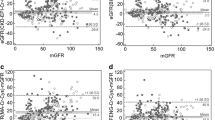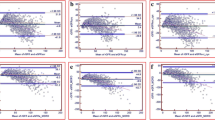Abstract
Purpose
Performance of equations in elderly with chronic kidney disease (CKD) was debated. We aimed to access the performances of estimating equations for glomerular filtration rate in Chinese elderly population with chronic kidney disease.
Methods
Participants [N = 218, median age, 82 (range 75–96)] with CKD underwent renal dynamic imaging using technetium-99m diethylene-triamine-penta-acetic acid (99mTc-DTPA). The performances of glomerular filtration rate equations including the Cockcroft–Gault equation, the MDRD (Modification of Diet in Renal Disease) equation for Chinese, 3 CKD-EPI (Chronic Kidney Disease Epidemiology Collaboration) equations, and 2 BIS (Berlin Initiative Study) equations were compared.
Results
Median mGFR was 47.62 (3.00–135.00) ml/min/1.73 m2. Smaller biases were shown in BIS-2 equation and CKD-EPI-Cr equation (0.63 ml/min/1.73 m2 and −1.22 ml/min/1.73 m2). Interquartile range of the differences was least with BIS-2 equation and CKD-EPI-Cr-Cys equation (4.36 ml/min/1.73 m2 and 9.17 ml/min/1.73 m2). For accuracy (percentage of eGFR within 30 % of the mGFR, P30), performance of BIS-2, CKD-EPI-Cr-Cys, and BIS-1 equation was superior (94.50, 89.91, and 88.53 %, respectively). In terms of accuracy (root-mean-square error, RMSE), BIS-2 equation, CKD-EPI-Cr-Cys equation, and BIS-1 equation also performed better (7.21 ml/min/1.73 m2, 8.87 ml/min/1.73 m2 and 9.82 ml/min/1.73 m2). GFR category misclassification rates were smaller in BIS-2 equation, CKD-EPI-Cr-Cys equation and BIS-1 equation (16.51, 20.64, and 25.69 %, respectively).
Conclusion
Compared with other equations, the BIS-2 equation performed better in the estimation of glomerular filtration rate for Chinese elderly with CKD aged 75 or above.

Similar content being viewed by others
References
Chen W, Chen W, Wang H et al (2009) Prevalence and risk factors associated with chronic kidney disease in an adult population from southern China. Nephrol Dial Transpl 24:1205–1212
Zhang L, Zhang P, Wang F et al (2008) Prevalence and factors associated with CKD: a population study from Beijing. Am J Kidney Dis 51:373–384
Liu BC, Wu XC, Wang YL et al (2008) Investigation of the prevalence of CKD in 13,383 Chinese hospitalised adult patients. Clin Chim Acta 387:128–132
Stevens LA, Coresh J, Greene T et al (2006) Assessing kidney function—measured and estimated glomerular filtration rate. N Engl J Med 354:2473–2483
Dharnidharka VR, Kwon C, Stevens G (2002) Serum cystatin C is superior to serum creatinine as a marker of kidney function: a meta-analysis. Am J Kidney Dis 40:221–226
Inker LA, Schmid CH, Tighiouart H et al (2012) Estimating glomerular filtration rate from serum creatinine and cystatin C. N Engl J Med 367:20–29
Levey AS, Bosch JP, Lewis JB et al (1999) A more accurate method to estimate glomerular filtration rate from serum creatinine: a new prediction equation. Modification of Diet in Renal Disease Study Group. Ann Intern Med 130:461–470
Levey AS, Stevens LA, Schmid CH et al (2009) A new equation to estimate glomerular filtration rate. Ann Intern Med 150:604–612
Kilbride HS, Stevens PE, Eaglestone G et al (2013) Accuracy of the MDRD (Modification of Diet in Renal Disease) study and CKD-EPI (CKD Epidemiology Collaboration) equations for estimation of GFR in the elderly. Am J Kidney Dis 61:57–66
Liu X, Cheng MH, Shi CG et al (2012) Variability of glomerular filtration rate estimation equations in elderly Chinese patients with chronic kidney disease. Clin Interv Aging 7:409–415
Schaeffner ES, Ebert N, Delanaye P et al (2012) Two novel equations to estimate kidney function in persons aged 70 years or older. Ann Intern Med 157:471–481
National Kidney Foundation (2002) K/DOQI clinical practice guidelines for chronic kidney disease: evaluation, classification, and stratification. Am J Kidney Dis 39(2 Suppl 1):S1–S266
Heikkinen JO, Kuikka JT, Ahonen AK et al (2001) Quality of dynamic radionuclide renal imaging: multicentre evaluation using a functional renal phantom. Nucl Med Commun 22:987–995
Gates GF (1984) Computation of glomerular filtration rate with Tc-99 m DTPA: an in-house computer program. J Nucl Med 25:613–618
Du Bois D, Du Bois EF (1989) A formula to estimate the approximate surface area if height and weight be known. 1916. Nutrition 5:303–311 (discussion 312-313)
Cockcroft DW, Gault MH (1976) Prediction of creatinine clearance from serum creatinine. Nephron 16:31–41
Ma YC, Zuo L, Chen JH et al (2006) Modified glomerular filtration rate estimating equation for Chinese patients with chronic kidney disease. J Am Soc Nephrol 17:2937–2944
Zhang L, Wang F, Wang L et al (2012) Prevalence of chronic kidney disease in China: a cross-sectional survey. Lancet 379:815–822
Chadban SJ, Briganti EM, Kerr PG et al (2003) Prevalence of kidney damage in Australian adults: the AusDiab kidney study. J Am Soc Nephrol 14:S131–S138
Coresh J, Selvin E, Stevens LA et al (2007) Prevalence of chronic kidney disease in the United States. JAMA 298:2038–2047
Yamagata K, Yagisawa T, Nakai S et al (2015) Prevalence and incidence of chronic kidney disease stage G5 in Japan. Clin Exp Nephrol 19:54–64
Zhang QL, Rothenbacher D (2008) Prevalence of chronic kidney disease in population-based studies: systematic review. BMC Public Health 8:117
Kurella M, Covinsky KE, Collins AJ et al (2007) Octogenarians and nonagenarians starting dialysis in the United States. Ann Intern Med 146:177–183
Lin MY, Chiu YW, Lee CH et al (2013) Factors associated with CKD in the elderly and nonelderly population. Clin J Am Soc Nephrol 8:33–40
Swedko PJ, Clark HD, Paramsothy K et al (2003) Serum creatinine is an inadequate screening test for renal failure in elderly patients. Arch Intern Med 163:356–360
Van Pottelbergh G, Van Heden L, Mathei C et al (2010) Methods to evaluate renal function in elderly patients: a systematic literature review. Age Ageing 39:542–548
Huang Q, Sun X, Chen Y et al (2015) A study of the applicability of GFR evaluation equations for an elderly Chinese population. J Nutr Health Aging 19:693–701
Van Pottelbergh G, Mertens A, Azermai M et al (2014) Drug prescriptions unadapted to the renal function in patients aged 80 years and older. Eur J Gen Pract 20:190–195
Liu X, Chen J, Wang C et al (2013) Assessment of glomerular filtration rate in elderly patients with chronic kidney disease. Int Urol Nephrol 45:1475–1482
Ye X, Wei L, Pei X et al (2014) Application of creatinine- and/or cystatin C-based glomerular filtration rate estimation equations in elderly Chinese. Clin Interv Aging 9:1539–1549
Lopes MB, Araujo LQ, Passos MT et al (2013) Estimation of glomerular filtration rate from serum creatinine and cystatin C in octogenarians and nonagenarians. BMC Nephrol 14:265
Koppe L, Klich A, Dubourg L et al (2013) Performance of creatinine-based equations compared in older patients. J Nephrol 26:716–723
Finney H, Newman DJ, Thakkar H et al (2000) Reference ranges for plasma cystatin C and creatinine measurements in premature infants, neonates, and older children. Arch Dis Child 82:71–75
Norlund L, Fex G, Lanke J et al (1997) Reference intervals for the glomerular filtration rate and cell-proliferation markers: serum cystatin C and serum beta 2-microglobulin/cystatin C-ratio. Scand J Clin Lab Invest 57:463–470
Tangri N, Stevens LA, Schmid CH et al (2011) Changes in dietary protein intake has no effect on serum cystatin C levels independent of the glomerular filtration rate. Kidney Int 79:471–477
Vinge E, Lindergard B, Nilsson-Ehle P et al (1999) Relationships among serum cystatin C, serum creatinine, lean tissue mass and glomerular filtration rate in healthy adults. Scand J Clin Lab Invest 59:587–592
Stevens LA, Schmid CH, Greene T et al (2009) Factors other than glomerular filtration rate affect serum cystatin C levels. Kidney Int 75:652–660
Knight EL, Verhave JC, Spiegelman D et al (2004) Factors influencing serum cystatin C levels other than renal function and the impact on renal function measurement. Kidney Int 65:1416–1421
Pei X, Liu Q, He J et al (2012) Are cystatin C-based equations superior to creatinine-based equations for estimating GFR in Chinese elderly population. Int Urol Nephrol 44:1877–1884
Fan L, Levey AS, Gudnason V et al (2015) Comparing GFR estimating equations using cystatin C and creatinine in elderly individuals. J Am Soc Nephrol 26:1982–1989
Van Pottelbergh G, Vaes B, Adriaensen W et al (2014) The glomerular filtration rate estimated by new and old equations as a predictor of important outcomes in elderly patients. BMC Med 12:27
Author information
Authors and Affiliations
Corresponding author
Ethics declarations
Conflict of interest
The authors declare that they have no conflicts of interest.
Rights and permissions
About this article
Cite this article
Changjie, G., Xusheng, Z., Feng, H. et al. Evaluation of glomerular filtration rate by different equations in Chinese elderly with chronic kidney disease. Int Urol Nephrol 49, 133–141 (2017). https://doi.org/10.1007/s11255-016-1359-z
Received:
Accepted:
Published:
Issue Date:
DOI: https://doi.org/10.1007/s11255-016-1359-z




